Explore the intricacies of inductive impedance bridges, their types, applications, advantages, and recent advancements in this comprehensive guide.

Understanding Inductive Impedance Bridges
Inductive impedance bridges are critical instruments used in electronic circuits to measure unknown inductance, resistance, and sometimes even frequency. These bridges rely on the fundamental principles of AC circuits, including Ohm’s Law and Kirchhoff’s Laws, enabling precise and reliable measurements.
Components of an Inductive Impedance Bridge
An inductive impedance bridge typically consists of four arms. The first arm incorporates an inductor whose inductance is to be determined, while the second arm includes a known inductor. The third and fourth arms contain known resistors. The bridge also comprises an AC source, a detector, and an adjustable component for balancing the bridge.
Operation Principle
The functioning of an inductive impedance bridge is grounded in the principle of a balanced bridge circuit. When the bridge is balanced, no current flows through the detector, ensuring that the sum of potential drops in one loop equals that in the other. Therefore, we can create an equation system that allows us to solve for the unknown inductance.
Types of Inductive Impedance Bridges
- Maxwell Bridge: A type of inductive impedance bridge specifically designed for measuring self-inductance. In a Maxwell bridge, the known components are purely resistive.
- Hay Bridge: A variation of Maxwell’s Bridge, Hay Bridge compensates for the presence of a small amount of resistance in the inductor under test. It provides a high degree of accuracy.
- Wien Bridge: Although mainly used for measuring unknown capacitance or frequency, Wien bridge can also measure inductance when appropriately modified.
Understanding these different types of bridges is essential in selecting the right one for specific applications. Their design ensures optimal performance and accuracy based on the characteristics of the components under test.
Applications of Inductive Impedance Bridges
Inductive impedance bridges are widely used in several areas of electrical and electronics engineering. Their primary application is the measurement of an unknown inductor’s inductance. However, they are also employed in measuring impedance, reactance, and even frequency in certain configurations. Moreover, they are an integral part of electrical instrumentation and measurement systems, telecommunication networks, and quality control in inductor manufacturing.
Advantages and Disadvantages of Inductive Impedance Bridges
One of the main advantages of inductive impedance bridges is their precision in measuring unknown inductance. Given that the bridge is properly balanced and the known components are accurate, these instruments can provide highly accurate measurements. Furthermore, they are quite versatile as they can be used to measure resistance and frequency, depending on the configuration.
However, there are also a few drawbacks to consider. The accuracy of these bridges depends on the balance of the bridge, which can be influenced by external factors like temperature, humidity, and physical vibrations. Moreover, the process of balancing the bridge can be time-consuming and requires considerable skill and understanding of the principles involved.
Recent Developments
With advancements in technology, digital impedance bridges have come into existence that utilize digital computation methods for achieving balance, thereby eliminating the need for manual adjustments and the associated errors. Digital bridges offer enhanced accuracy, ease of use, and faster measurements, which have widened the scope of applications of impedance bridges in various industries.
Conclusion
Inductive impedance bridges are indispensable tools in the realm of electrical and electronics engineering. Their ability to precisely measure unknown inductance, along with resistance and frequency, makes them highly valuable for various applications. While traditional inductive impedance bridges have their limitations, digital advancements promise to overcome these challenges, making impedance measurement more accessible and reliable. As we move forward, we can expect further improvements and new applications of this vital technology.

